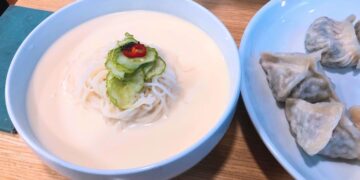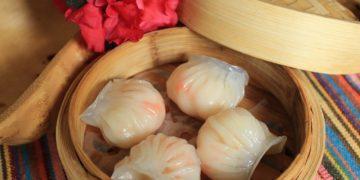There are some things you can pack in your suitcase. A box of tea. A pair of socks from Hongdae. A tube of gochujang from a supermarket aisle in Myeongdong. But tteokbokki? That’s not something you take home in a plastic container. You have to actually be there—standing on a bustling Seoul corner, mouth tingling, eyes wide open—to understand what this dish really means and what it does really symbolize. Because beyond its iconic taste, tteokbokki holds a deep cultural significance in South Korea, and today we’re going to guide you to better understand about this hearty soul food.
Beyond Mere Street Food: The Real Cultural Significance of Tteokbokki
If you’re traveling to South Korea, you won’t just eat tteokbokki—you’ll live through it. Because this isn’t simply a street food or a trendy menu item. Tteokbokki is one of the most visceral cultural experiences you can have as a traveler in Korea. It holds flavor, yes—but also memory, emotion, and a nation’s evolving identity, simmered into a single bite.
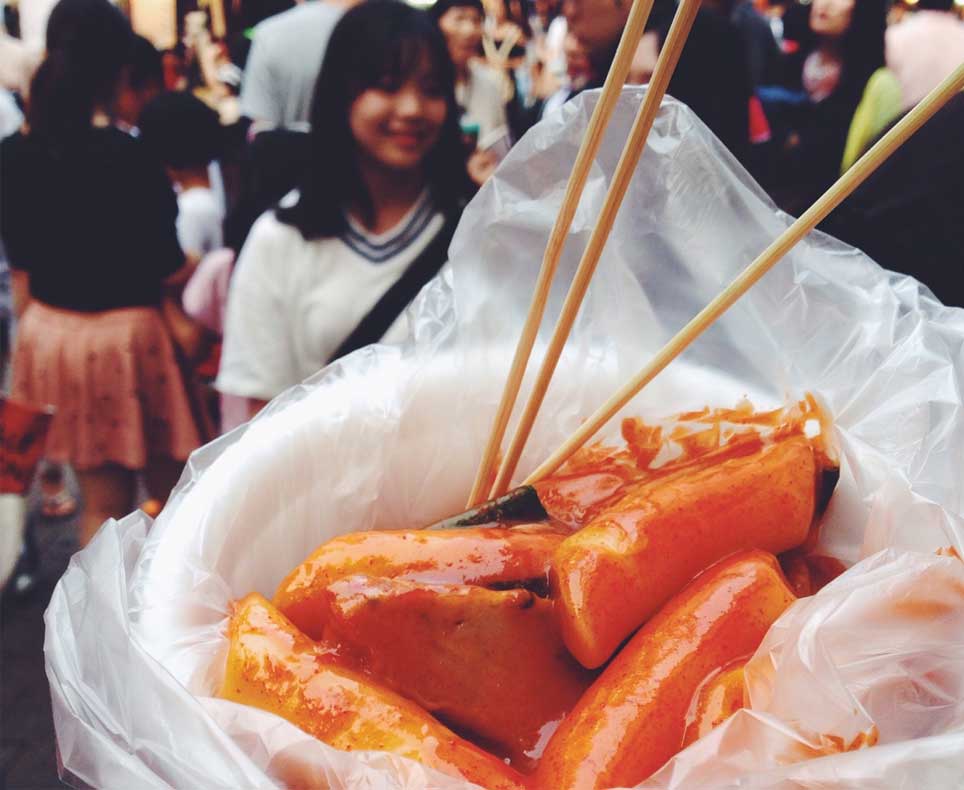
Ask a Korean what tteokbokki reminds them of, and the answer likely won’t start in the kitchen. It’ll start at a middle school gate, waiting with friends after cram school. Or during a chilly night, wrapped in jackets, huddled around a pojangmacha cart. Or maybe even in front of the TV with a steaming bowl after a long, stressful day.
What Does Tteokbokki Symbolize?
Beyond its popularity as one of world’s most famous street food, what does tteokbokki symbolize in South Korea is the cultural significance of togetherness. The kind that comes with shared meals, with sauce-smeared smiles, with chopsticks crossing paths in a bubbling pot of jeukseok tteokbokki.
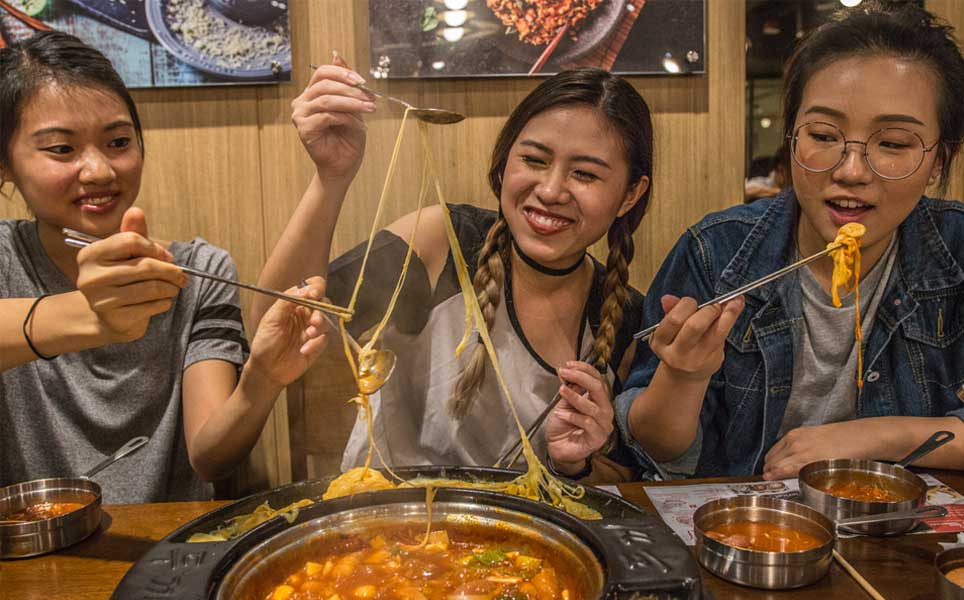
And this is something you cannot mass produce and definitely cannot microwave into existence. Instead, you have to actually be there in person to experience them.
What Is a Tteokbokki Made Of?
Traditionally, tteokbokki is made of garae-tteok—cylindrical, chewy rice cakes that absorb the sauce like sponges of nostalgia. These are simmered in gochujang, a deep red chili paste that’s fermented, sweet, smoky, and spicy all at once. Add to that eomuk (fish cakes), boiled eggs, scallions, and a ladleful of kelp-anchovy broth, and you’ve got the classic base.
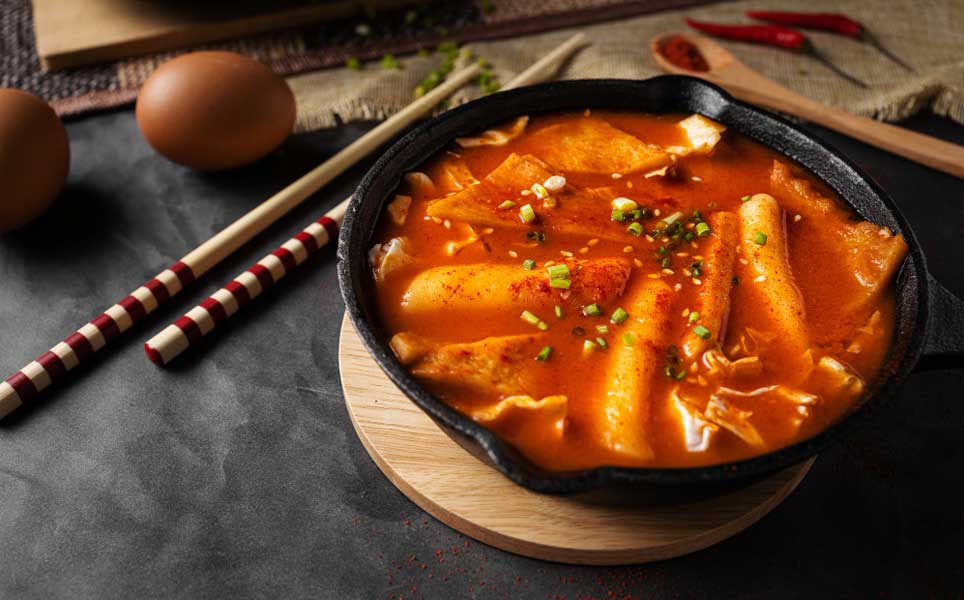
But that’s just the starting point. Walk through Seoul today and you’ll find galbi-tteokbokki made with short ribs, rose tteokbokki in cream sauce, curry tteokbokki yellowed with turmeric, and even mala-tteokbokki, which borrows bold numbing spices from Chinese Sichuan cuisine.
That is why when someone asks, What is a tteokbokki made of?—the honest answer is: it’s made of South Korea’s past and present.
Because tteokbokki might begin with simple rice cakes and sauce. But beyond that, it’s shaped by the flavors Koreans have grown up with, the cravings they’ve reinvented, and the stories they’ve stirred into every pan.
Hence, what you taste isn’t just a list of ingredients—it’s a snapshot of Korean life, past and present, constantly evolving but never forgetting its roots.
What Does the Tteokbokki Taste Like?
There’s no single answer to “What does the tteokbokki taste like?”—and that’s part of the magic.
The classic tteokbokki version, swimming in gochujang sauce, tastes like a sensual mix of chewy, spicy, sweet, and savory. Each rice cake resists your bite just enough before yielding to warmth and fire. The sauce lingers, clinging to your lips and thoughts long after the last piece is gone.
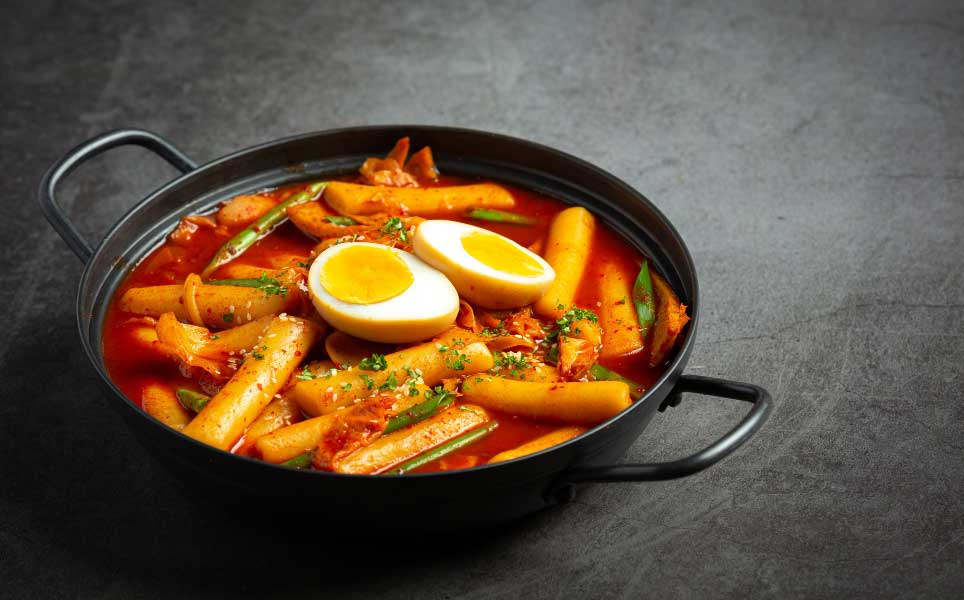
Then there’s gungjung tteokbokki, a royal ancestor that predates chili in Korean cuisine. Made with soy sauce, sesame oil, beef strips, and nuts, it’s subtle, nutty, and noble—a reminder that tteokbokki once graced palaces before it ever hit the pavement.
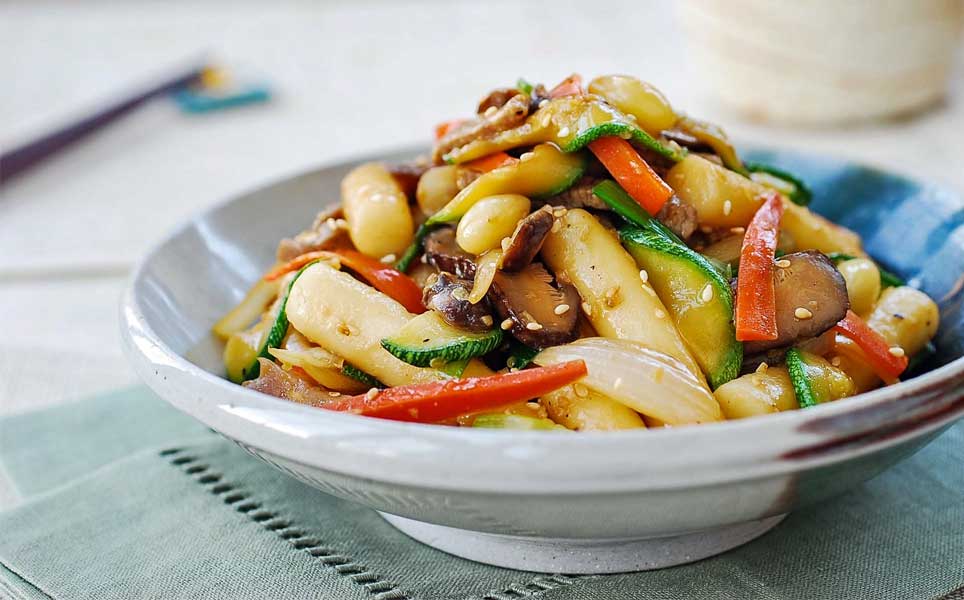
Meanwhile, gireum-tteokbokki, stir-fried in oil and often served dry, crackles with garlic and sesame, revealing another facet of the dish’s ever-shifting identity.
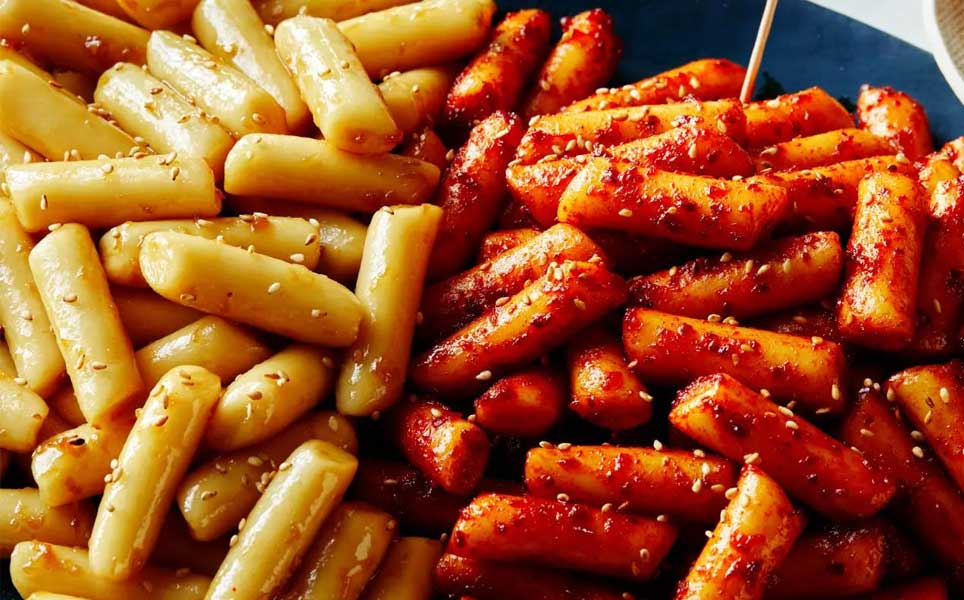
So, what does tteokbokki taste like? It tastes like home for some, heat for others, and discovery for you.
Tteokbokki’s Cultural Significance: Why It Matters to Travelers
Tteokbokki is Korea’s unofficial welcome mat. If kimchi is the national signature, tteokbokki is the handwritten note beneath it, urging you to stay a little longer and feel a little deeper. It’s a dish that adapts—because Korea adapts. It has accompanied Korea through war recovery, rapid modernization, and global cultural waves.
In post-war Korea, when rice was scarce and flour was abundant due to U.S. aid, wheat-based tteok entered the scene. By the 1950s, a Seoul woman named Ma Bok Rim reinvented the dish by adding gochujang and selling it at a small pojangmacha in Sindang-dong. That single act created what we now recognize as modern spicy tteokbokki, transforming the dish into a cultural icon.
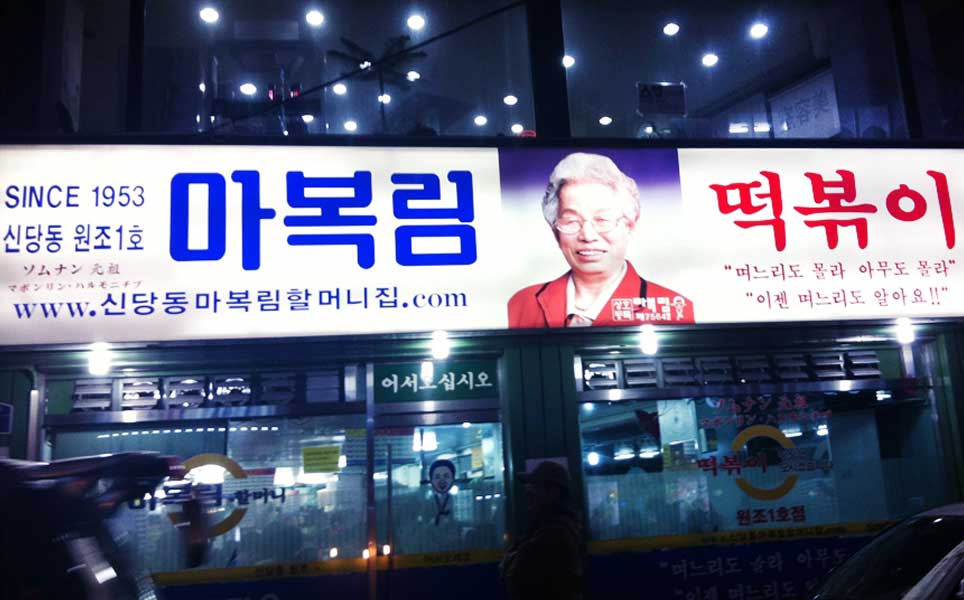
Today, tteokbokki is not only a culinary ambassador of Korean culture, but also an expression of intergenerational resilience and ingenuity. You can find it at baseball stadiums in America, dorm rooms in Europe, and airport kiosks in Southeast Asia. But as a traveler, tasting it where it was born—not reinterpreted—is something else entirely.
It’s the difference between looking at a painting online and seeing the brushstrokes in person.
The Importance of Eating Tteokbokki In Korea
Yes, there are instant cups. Yes, you can order a premium frozen version online. And while they’re decent, they aren’t the story.
Street tteokbokki in Korea is a living performance.
You’ll see silver trays of bubbling red sauce, hear the sound of rice cakes tossed in metal pans, smell the blend of gochujang and garlic bleeding into the air. You’ll watch locals pause mid-conversation to lean in for a bite, steam curling up into their faces, eyes squinting at the heat.
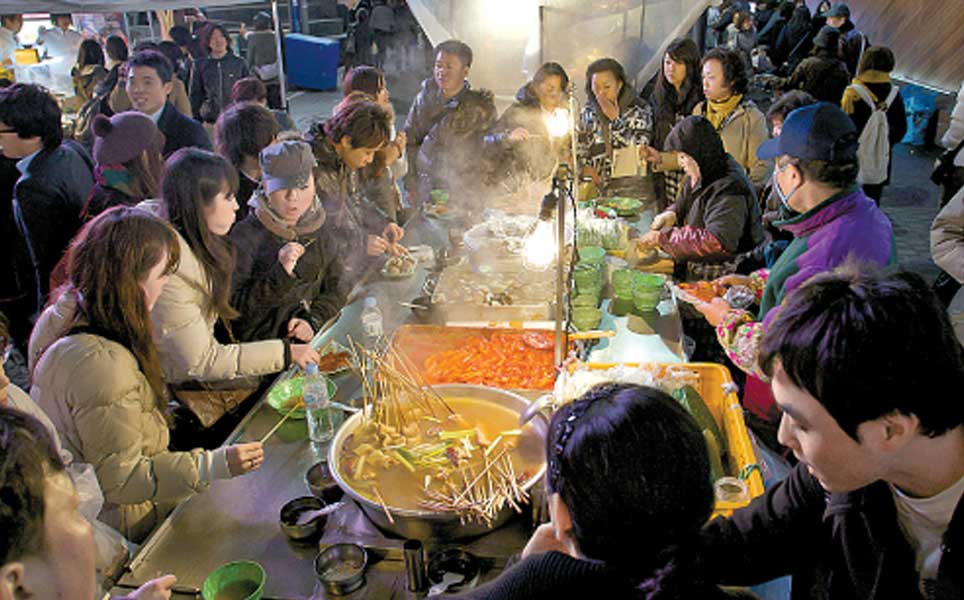
And that’s where you belong too—not behind a screen or packet, but right there, breathing in the moment, sharing a paper cup of tteokbokki on the side of a neon-lit alley.
Where and How to Eat Tteokbokki Like a Local: A Brief Traveler’s Guide
If you’re here to experience tteokbokki, don’t settle for what’s already been prepped, packaged, or filtered through an international lens. This is one dish where location, atmosphere, and participation matter just as much as flavor.
So where should you go—and more importantly, how should you eat it? Let’s take you through the most authentic tteokbokki encounters across South Korea.
The Pojangmacha Experience: Street Flavor, Pure and Unfiltered
You haven’t really felt tteokbokki until you’ve stood shoulder-to-shoulder with locals at a pojangmacha—those tented street carts glowing under Seoul’s nightscape. Head to Euljiro, Yeongdeungpo Market, or even those nameless backstreets behind subway exits in Sinchon or Hongdae. Just follow the aroma of spicy gochujang hanging in the air.
Order the classic spicy version in a paper cup, maybe with a skewer of fish cake on the side, and eat standing up. Then, try chatting with the ahjumma who made it, even you’re using broken Korean. The point is to actually live the experience – the cultural significance that tteokbokki symbolizes – yourself. It’s about feeling present—eating something simple, spicy, and undeniably Korean in the middle of everything.
Jeukseok Tteokbokki: Make It Your Way, At the Table
If you’re traveling in a group—or even solo but craving a meal that feels like an experience—seek out a jeukseok tteokbokki (즉석떡볶이) restaurant. “Jeukseok” means “on-the-spot,” and these spots give you the ingredients raw, ready to boil and stir-fry yourself at your own table.
Go to Mukshidonna (a famous chain with a cozy location in Samcheong-dong near Bukchon Hanok Village) or try independent shops around Daehangno or Gangnam.
Start with the rice cakes and spicy base, then add what speaks to your cravings: ramyeon, cheese, dumplings, sausages, even shrimp or bacon. The staff usually brings you rice at the end—so you can stir it into the leftover sauce and create bokkeumbap (fried rice) for a delicious encore.
In the end, Jeukseok tteokbokki symbolizes a group ritual, where you cook together, mess up together, and leave a little sweat on your upper lip from both the spice and the laughter.
Tracing the Royal Origins: Gungjung Tteokbokki in Historic Settings
Want to connect with tteokbokki’s pre-modern past? Look for gungjung-tteokbokki (궁중떡볶이)—the soy sauce-based, non-spicy version that once fed Korea’s royals.
You’ll find the most meaningful versions of this dish in culturally rich cities like Jeonju, or in Seoul near Gyeongbokgung Palace or Insadong, often served in hanok-style restaurants. Some cafés will even plate it with traditional garnishes like pine nuts or jujubes.
Now what does Gungjung Tteokbokki taste like?
Well, this version is gentle, elegant—less of a street explosion and more of a quiet conversation with history. For those who prefer less heat or travel with kids, Gungjung Tteokbokki will taste like the perfect entry point into this world.
Local Markets for Specialty Twists
If you’re in the mood to taste something offbeat, local markets are treasure maps. Visit:
- Tongin Market (Jongno): Famous for its gireum-tteokbokki, where the rice cakes are stir-fried in oil rather than simmered in sauce. Slightly crispy, subtly salty—it’s a market original you won’t find in tourist zones.
- Seomun Market (Daegu): A hotspot for cheese tteokbokki, often served on cast-iron skillets and paired with deep-fried snacks like twigim.
- Seogwipo Maeil Olle Market (Jeju): You’ll find seafood-tteokbokki with a local twist, thanks to Jeju’s oceanic bounty.
Markets are ideal if you want a bite-sized culinary adventure. No two stalls serve it the same way—and that’s the point.
Quick Tips Before You Go:
- Don’t wear white when trying spicy tteokbokki. You’ll thank us later.
- Cash is king at many street vendors. ₩5,000–₩8,000 will go a long way.
- Don’t be shy about asking locals for their favorite stall. Most will happily point you in the right direction—and some may even join you.
- If you’re spice-sensitive, say “덜 맵게 해 주세요” (deol maepge hae juseyo)—“Please make it less spicy.”
Tteokbokki holds the cultural significance as one of Korea’s most democratized foods. It asks nothing of you—no reservations, no dress code, no language fluency. All it wants is for you to try—to bite into something unfamiliar, to share it with someone, to remember it not just with your taste buds but your heart.
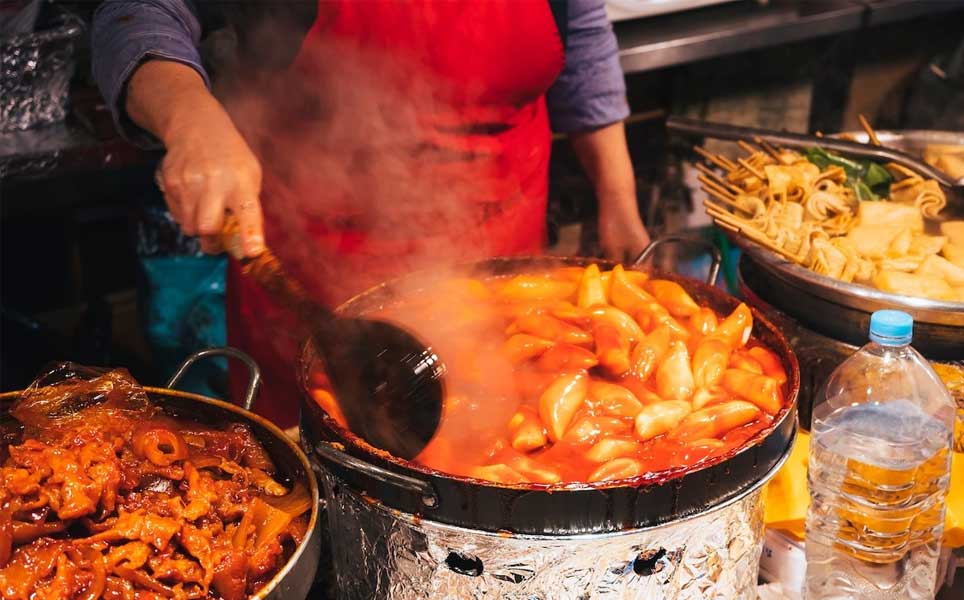
Taste the Authentic Tteokbokki Experience in South Korea
There’s a reason tteokbokki refuses to disappear, no matter how Korea modernizes. Because the food is way more than just a spicy rice cake.
Tteokbokki holds the country’s deep cultural significance, the heartbeat of Korea’s everyday life. It unites kids and elders, poor and rich, Seoulites and countryside locals. And as a traveler, it lets you in—not as an outsider with a camera, but as someone who belongs, if only for a moment, to the rhythm of the city.
So come hungry—but come curious. Don’t ask just what does tteokbokki taste like? Or what is it made of? Instead, ask what it stands for. What it reveals. What it whispers to those who sit beside it, chopsticks in hand, stories shared in the steam between bites.
And when you take that first bite—not from a packet, but from the actual streets of Korea—you’ll understand that tteokbeokki doesn’t merely hold the cultural significance of South Korea.
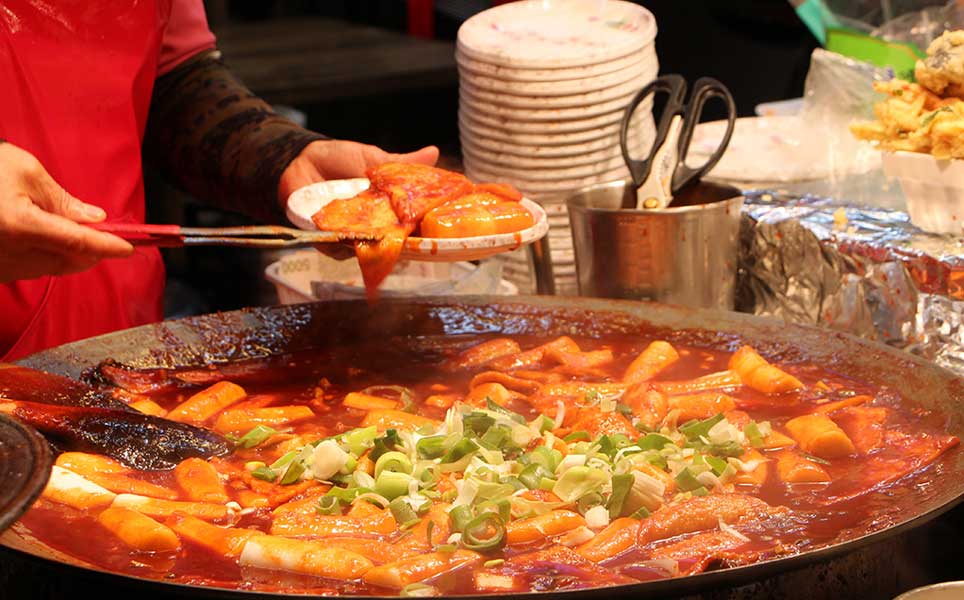
Tteokbokki is the culture.
Related Posts
4,564 total views, 8 views today





